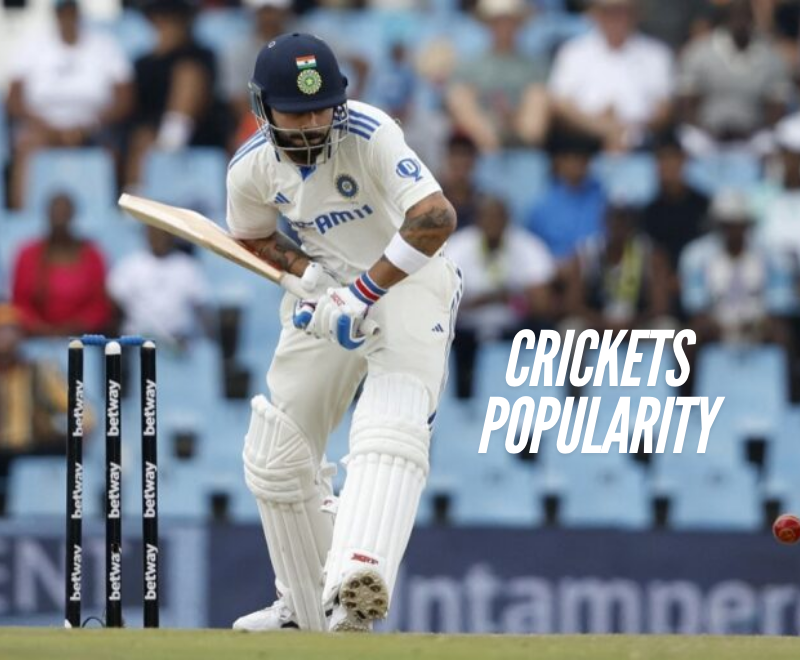Cricket has grown far beyond being just a sport; it’s now a global phenomenon. From Test cricket’s endurance-driven matches to the entertainment-packed IPL, cricket offers something for every kind of fan. Today, it’s played and watched by billions, especially across India, Australia, England, Pakistan, and Bangladesh. The game’s charm lies in its diverse formats, iconic players, and thrilling tournaments that attract new audiences while keeping long-time fans engaged.
In this guide, we explore why cricket has become so popular, how it evolved over centuries, and what the future holds for this beloved sport. Whether you’re a new fan or a seasoned cricket lover, this article provides a complete breakdown of the game’s appeal.
Cricket’s Growth into a Global Sport
Cricket has its roots in 16th-century England, but today it is celebrated in stadiums across continents. With over 2.5 billion fans worldwide, it’s one of the most-watched sports globally, especially during major tournaments like the ICC World Cup and Indian Premier League (IPL). But what makes cricket so popular?
The sport thrives on its flexibility—offering everything from five-day Test matches to 90-minute T10 games. It has also adapted to different cultures, becoming a symbol of pride and unity in many countries.
The History of Cricket: From Local Game to Global Phenomenon
Cricket’s history began in rural England during the 16th century as a leisurely pastime. Over the next few centuries, it spread to countries under British colonial influence, particularly India, Australia, South Africa, and the West Indies.
- The First Test Match: In 1877, Australia and England played the first official Test match, marking the beginning of international cricket.
- The Ashes Rivalry: In 1882, England and Australia’s intense rivalry birthed The Ashes, one of the oldest cricket competitions.
- India’s World Cup Triumph: India’s 1983 World Cup win inspired generations, making the sport immensely popular in the subcontinent.
Today, cricket is celebrated not only for its historic roots but also for how it has embraced innovation to stay relevant in the modern era.
Cricket’s Formats: Something for Every Fan
Cricket’s variety of formats is one of the key reasons for its growing popularity. Each format offers a unique experience, appealing to different types of audiences.
1. Test Cricket: The Ultimate Test of Skill and Patience
Test cricket is considered the purest form of the game. These matches, which last up to five days, test a team’s endurance, strategy, and technical skill.
- Iconic Test series: The Ashes and India vs Australia’s Border-Gavaskar Trophy.
- Famous players: Steve Smith, Ben Stokes, Virat Kohli.
Despite the rise of shorter formats, Test cricket remains a favorite for purists who appreciate the technical intricacies of the game.
2. ODI Cricket: A Perfect Blend of Tradition and Speed
ODI cricket, or One Day Internationals, was introduced to make cricket more exciting and fast-paced.
- Key event: The ICC World Cup, held every four years, showcases the world’s best teams.
- Memorable moments: India’s 2011 World Cup win and England’s thrilling 2019 final victory.
ODIs strike a balance between the endurance of Test cricket and the speed of T20 matches, making them a favorite format for many fans.
3. T20 and T10 Cricket: Fast-Paced and Thrilling
T20 cricket has become the most popular format in recent years due to its short, action-packed nature. A match lasts just about three hours, making it ideal for modern audiences.
- IPL, BBL, and PSL are some of the most popular T20 leagues.
- T10 Cricket pushes the boundaries further by reducing matches to just 90 minutes, appealing to newer audiences and expanding the game’s reach to markets like the UAE and the USA.
Regional Cricket Powerhouses: Passion Across Continents
Cricket enjoys a massive following in several regions, with different countries contributing to the sport’s growth in unique ways.
1. India: Cricket’s Largest Fanbase
In India, cricket is nothing short of a religion. With over 1.3 billion people following the game, India plays a key role in cricket’s global success.
- IPL’s popularity: The IPL blends sport and entertainment, making it the most-watched T20 league in the world.
- Superstars: Players like Virat Kohli, MS Dhoni, and Rohit Sharma enjoy god-like status.
2. Australia and England: Traditional Cricketing Nations
Australia and England boast a rich cricketing history. The Ashes series remains one of the sport’s greatest rivalries, attracting viewers from around the world.
- Australia’s domestic tournaments like the BBL also showcase emerging talent.
- England’s county cricket system plays a crucial role in developing future stars.
3. Pakistan and Bangladesh: Cricket as a Unifying Force
In Pakistan and Bangladesh, cricket serves as a source of unity and pride. The PSL and BPL have become integral parts of these countries’ sporting culture, inspiring young players to take up the sport.
Iconic Players Who Defined Cricket
Great players shape the sport’s legacy. Here are some of the most influential cricketers across generations:
1. Legendary Cricketers
- Sachin Tendulkar: Known as the “God of Cricket,” Tendulkar’s career spanned more than two decades.
- Don Bradman: Considered the greatest batsman of all time, with an average of 99.94.
2. Modern Stars to Watch
- Virat Kohli: Known for his consistency across all formats and leadership skills.
- Babar Azam: Pakistan’s rising star, admired for his elegance and composure at the crease.
The Role of Technology in Modern Cricket
Technology has revolutionized how cricket is played, officiated, and experienced.
- DRS (Decision Review System): Ensures fairness by allowing players to challenge umpiring decisions.
- Data Analytics: Teams use data to analyze opponents and improve strategies.
- Wearables and Fitness Trackers: Help manage player workloads and prevent injuries.
Live streaming platforms and innovations in broadcasting also allow fans to engage with the game from anywhere in the world, enhancing cricket’s global reach.
Major Tournaments and Leagues: Driving Cricket’s Growth
Cricket’s most significant tournaments and leagues play a crucial role in its expansion.
- ICC World Cup: Held every four years, it’s the most prestigious event in the sport.
- IPL: The biggest T20 league, attracting international stars and generating huge revenue.
- The Ashes: A symbol of tradition and rivalry, drawing millions of viewers.
These events not only entertain fans but also provide platforms for emerging talent to shine.
The Future of Cricket: Trends to Watch
The future of cricket looks promising, with several trends shaping its growth:
- Expanding Markets: Cricket is making inroads into the USA, UAE, and Europe, with T20 leagues leading the charge.
- Women’s Cricket: The rise of women’s leagues and the Women’s World Cup is driving gender equality in the sport.
- Shorter Formats: T10 leagues may play a bigger role in attracting younger audiences.
- Inclusivity and Sustainability: Cricket boards are focusing on diversity initiatives and sustainable practices.
Why Cricket Continues to Thrive
Cricket’s ability to evolve with the times while preserving its traditions is key to its global appeal. Whether it’s the grit of Test cricket or the thrill of T20 leagues, cricket offers an experience for everyone.
As the sport continues to grow, it will inspire future generations, foster unity, and expand into new markets, ensuring that cricket’s legacy endures for decades to come.

